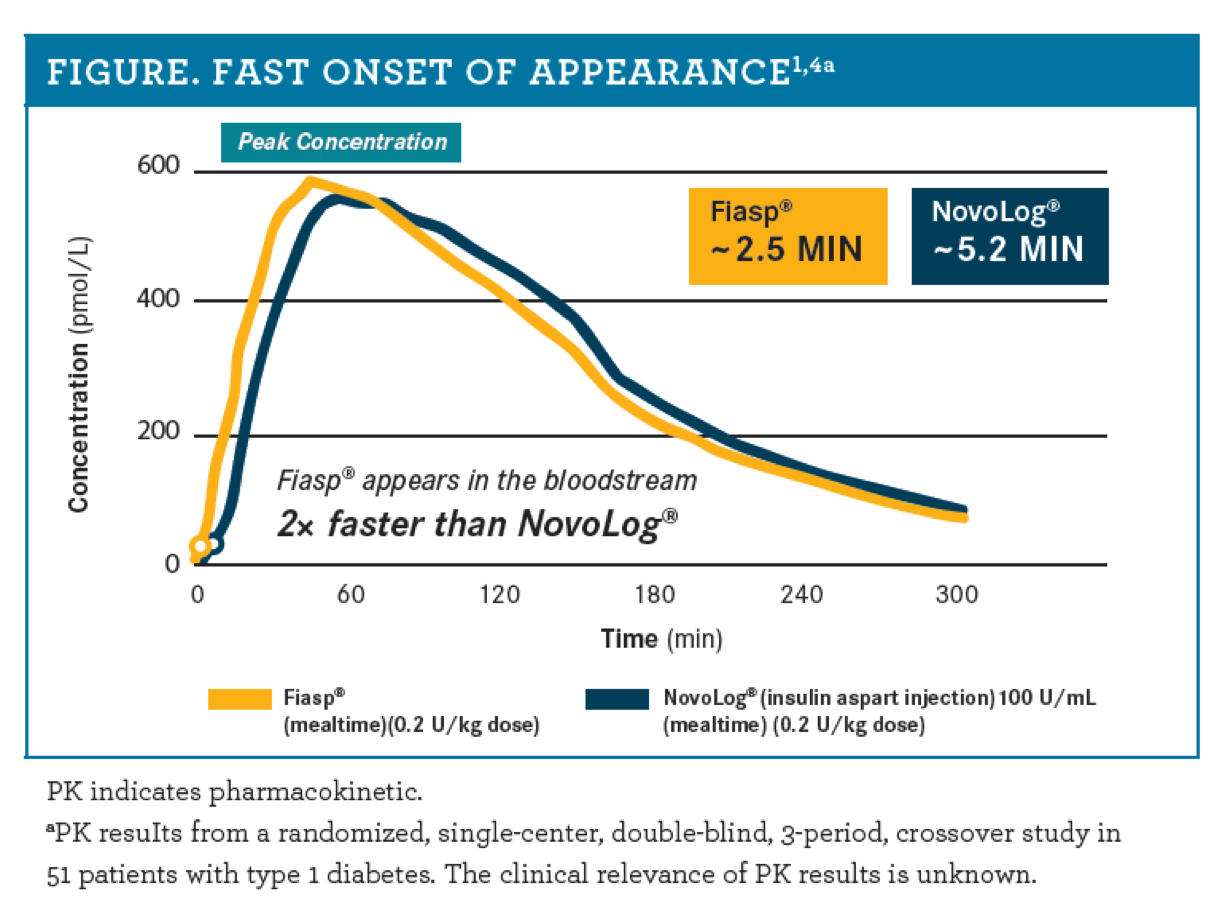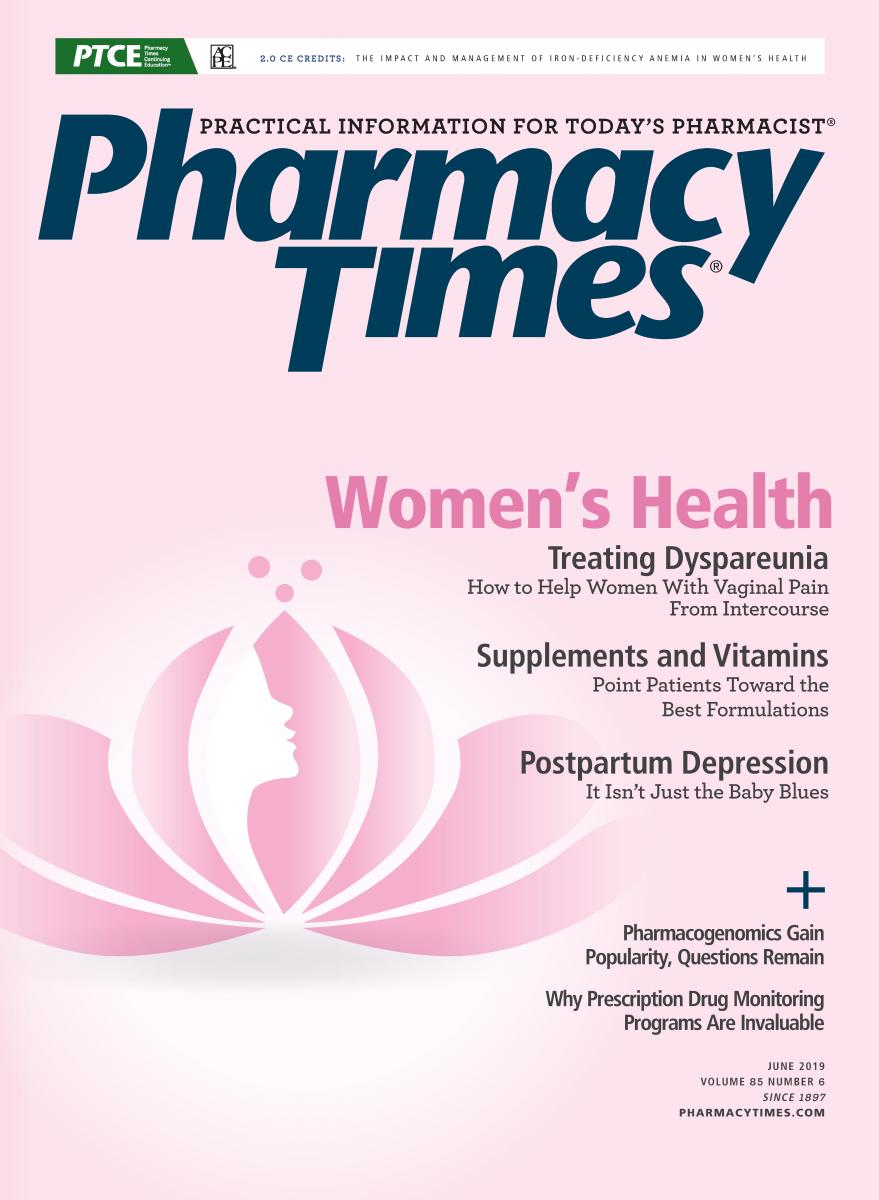Publication
Article
Pharmacy Times
Features of a Rapid-Acting Insulin Option for Adult Patients With Diabetes
This article is sponsored by Novo Nordisk.
Please see the Prescribing Information for Fiasp® (insulin aspart injection).Please see the Prescribing Information for Novolog® (insulin aspart injection).
Pharmacists are ideally positioned to counsel patients who are starting or currently using Fiasp® (insulin aspart injection) 100 units/mL, a rapid-acting insulin analog indicated to improve glycemic control in adults with diabetes mellitus.1 Please also see the Important Safety Information for Fiasp® and for Novolog® (insulin aspart injection) 100 U/mL at the end of this article.
The active molecule in Fiasp® is identical to Novolog® (insulin aspart injection) 100 U/mL.1,2 Fiasp® is a formulation of insulin aspart with 2 excipients added to the solution: vitamin B3 (niacinamide), to increase the speed of initial insulin absorption, and L-arginine, a formulation-stabilizing amino acid.1,3 Mealtime onset of appearance in the bloodstream is about 2.5 minutes compared with 5.2 minutes with NovoLog® (see
Figure
).1,4

MEALTIME DOSE TIMING
There are 2 ways to deliver Fiasp®, supplied in familiar presentations and packaging configurations:1
• 3-mL Fiasp® FlexTouch®, a prefilled insulin pen with no pushbutton extension
• 10-mL vial, available for patients who prefer conventional insulin injection
Fiasp® has flexible dosing options and may be administered:1
• With the first bite at the start of a meal
• During a meal, within 20 minutes of the first bite
Dosing conversion from another mealtime insulin to Fiasp® can be done on a unit-to-unit (1:1) basis, whether treating for type 1 diabetes or type 2 diabetes.1 NovoLog® has 1 dosing option and is administered 5 to 10 minutes before a meal.3
Ensure patients understand their dosing options, and provide education on missed doses.1 Instruct patients on basal-bolus treatment who forget a mealtime dose to monitor their blood glucose level to decide if an insulin dose is needed and resume their usual dosing schedule at the next meal. Patients may forget to take their dose before starting to eat. Because Fiasp® can be dosed at mealtime or within 20 minutes after starting a meal, educate patients that instead of skipping the dose, they can take Fiasp® within 20 minutes of the first bite.1
PRACTICAL CONSIDERATIONS
Because Fiasp® and NovoLog® have the same generic, insulin aspart 100 U/mL, awareness of best dispensing practices can ensure that the appropriate medication is dispensed to the patient. Pharmacists can confirm the desired brand name with the prescriber if it is not specified on the written script or in the e-prescribing system.
Important Safety Information Fiasp® (insulin aspart injection)
100 U/mL
Fiasp® (insulin aspart injection) 100 U/mL Indications and Usage
Fiasp® (insulin aspart injection) 100 U/mL is a rapid-acting insulin analog indicated to improve glycemic control in adults with diabetes mellitus.
Important Safety Information
Contraindications
- Fiasp® is contraindicated during episodes of hypoglycemia and in patients hypersensitive to Fiasp® or one of its excipients.
Warnings and Precautions
- Never share a Fiasp® FlexTouch® Pen, PenFill® cartridge or PenFill® cartridge device between patients, even if the needle is changed. Patients using Fiasp® vials must never share needles or syringes with another person. Sharing poses a risk for transmission of blood-borne pathogens.
- Changes in insulin strength, manufacturer, type, or method of administration may affect glycemic control and predispose to hypoglycemia or hyperglycemia. These changes should be made cautiously under close medical supervision and the frequency of blood glucose monitoring should be increased.
- Hypoglycemia is the most common adverse reaction of insulin, including Fiasp®, and may be life-threatening. Increase glucose monitoring with changes to: insulin dosage, co-administered glucose lowering medications, meal pattern, physical activity; and in patients with renal impairment or hepatic impairment or hypoglycemia unawareness.
- To avoid medication errors and accidental mix-ups between Fiasp® and other insulin products, instruct patients to always check the insulin label before injection.
- As with all insulins, Fiasp® use can lead to life-threatening hypokalemia, which then may cause respiratory paralysis, ventricular arrhythmia, and death. Monitor potassium levels in patients at risk for hypokalemia and treat if indicated.
- Severe, life-threatening, generalized allergy, including anaphylaxis, may occur with insulin products, including Fiasp®.
- Fluid retention and heart failure can occur with concomitant use of thiazolidinediones (TZDs), which are PPAR-gamma agonists, and insulin, including Fiasp®. Patients should be observed for signs and symptoms of heart failure. If heart failure occurs, dosage reduction or discontinuation of the TZD must be considered.
Adverse Reactions
- Adverse reactions observed with Fiasp® include hypoglycemia, allergic reactions, hypersensitivity, injection site reactions, lipodystrophy, and weight gain.
Use in Specific Populations
- The safety and effectiveness of Fiasp® in pediatric patients have not been established.
- Like all insulins, Fiasp® requirements may be reduced in patients with renal impairment or hepatic impairment. These patients may require more frequent blood glucose monitoring and dose adjustments.
Important Safety Information NovoLog® (insulin aspart injection) 100 U/mL
NovoLog® (insulin
aspart
injection) 100 U/mLIndications and Usage
NovoLog® (insulin aspart injection) 100 U/mL is an insulin analog indicated to improve glycemic control in adults and children with diabetes mellitus.
Important Safety InformationContraindications
- NovoLog® is contraindicated during episodes of hypoglycemia and in patients hypersensitive to NovoLog® or one of its excipients.
Warnings and Precautions
- Never Share a NovoLog® FlexPen, NovoLog® FlexTouch®, PenFill® Cartridge, or PenFill® Cartridge Device Between Patients, even if the needle is changed. Patients using NovoLog® vials must never share needles or syringes with another person. Sharing poses a risk for transmission of blood-borne pathogens.
- Changes in insulin strength, manufacturer, type, or method of administration may affect glycemic control and predispose to hypoglycemia or hyperglycemia. These changes should be made cautiously under close medical supervision and the frequency of blood glucose monitoring should be increased.
- Hypoglycemia is the most common adverse effect of insulin therapy. The timing of hypoglycemia may reflect the time-action profile of the insulin formulation. Glucose monitoring is recommended for all patients with diabetes and is particularly important for patients using external pump infusion therapy.
- To avoid medication errors and accidental mix-ups between NovoLog® and other insulin products, instruct patients to always check the insulin label before injection.
- Severe, life-threatening, generalized allergy, including anaphylaxis, may occur with insulin products, including NovoLog®.
- As with all insulins, NovoLog® use can lead to life-threatening hypokalemia, which then may cause respiratory paralysis, ventricular arrhythmia, and death. Monitor potassium levels in patients at risk for hypokalemia and treat if indicated.
- Fluid retention and heart failure can occur with concomitant use of thiazolidinediones (TZDs), which are PPAR-gamma agonists, and insulin, including NovoLog®. Patients should be observed for signs and symptoms of heart failure. If heart failure occurs, dosage reduction or discontinuation of the TZD must be considered.
- Malfunction of the insulin pump or insulin infusion set or insulin degradation can rapidly lead to hyperglycemia and ketoacidosis. Patients using insulin infusion pump therapy must be trained to administer insulin by injection and have alternate insulin therapy available in case of pump failure.
NovoLog® continuous subcutaneous infusion route (insulin pump): Do not mix NovoLog® with any other insulin or diluent.
Adverse Reactions
Adverse reactions observed with NovoLog® include hypoglycemia, allergic reactions, local injection site reactions, lipodystrophy, rash, and pruritus.
Use in Specific Populations
- NovoLog® has not been studied in children with type 2 diabetes or in children with type 1 diabetes who are younger than 2 years of age.
- Like all insulins, NovoLog® requirements may be reduced in patients with renal impairment or hepatic impairment. These patients may require more frequent blood glucose monitoring and dose adjustments.
REFERENCES
- Fiasp [prescribing information]. Plainsboro, NJ: Novo Nordisk Inc; 2018. www.novo-pi.com/fiasp.pdf. Accessed January 24, 2019.
- Heise T, Pieber TR, Danne T, Erichsen L, Haahr H. A pooled analysis of clinical pharmacology trials investigating the pharmacokinetic and pharmacodynamic characteristics of fast-acting insulin aspart in adults with type 1 diabetes. Clin Pharmacokinet. 2017;56(5):551-559. doi: 10.1007/s40262-017-0514-8.
- NovoLog [prescribing information]. Plainsboro, NJ; Novo Nordisk Inc; 2018. www.novo-pi.com/novolog.pdf. Accessed January 24, 2019.
- Data on file. Novo Nordisk, Inc., Plainsboro, NJ.
Cornerstones4Care®, Fiasp®, FlexPen®, FlexTouch®, NovoLog®, PenFill®, and onset® are registered trademarks and NovoMedLink™ is a trademark of Novo Nordisk A/S.
Novo Nordisk is a registered trademark of Novo Nordisk A/S.
All other trademarks, registered or unregistered, are the property of their respective owners.
© 2019 Novo Nordisk US19FSP00022







